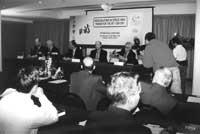Conclusions of the Donostia Steel Microalloy Congress
Almost two years ago we started organizing this congress, and although from the beginning we thought it would be a congress little participatory, it has not been so. Our first intention was to bring together 100 experts. As we moved forward in the organization, we increased the number to 150 and, finally, when the opening ceremony came, we were 200 people. Along with this change, there was another remarkable feature: half of the congressmen came from the industry.
We met twenty-two state congressmen and, as we have indicated, half came from universities and research centers and the other half of the industry. That is, at the congress the two sides of R&D were gathered around the microalloy of steel. This has not been accidental, and to some extent it is an indicator of the changes taking place in the world of steel.
The microalloy technique allows to substantially modify the properties of a steel. For this it is necessary to adapt the chemical composition of the steel adding very few elements (Ti, V, Nb, B, etc. ). In addition, the steel forming process (lamination, forging, etc.) must be controlled. so that the interaction between precipitation and microstructures that generate these elements in the process is satisfactory.
Explaining things like this, it seems that microalloy is a procedure of little difficulty. However, when it is said that it is necessary to control the particles of 20 nanometers in the steel pouring of 120 tons and its subsequent forming, and that we must also do so without losing productivity, we realize the complexity of the procedure. Also, each type of steel has its particularities and many criteria cannot be considered general.
It is in this context that we must place the congress. Microalloy technology has enabled significant improvements in numerous types of steel, both mechanically and productively.

But these achievements cannot be achieved without extensive laboratory work. Solidification, kinetics of particle precipitation, dynamic changes of forming microstructures, phase transformational, etc. are researched and analyzed in laboratories and then the results are applied to the industry. Now the industry needs the results of the laboratory and, at the same time, in order to make laboratory simulations ever more accurate, an increasing knowledge of industrial conditions is necessary.
The participation of universities, research centers and industry is based on this. However, it must be said that the industry would not participate if it did not suspect a new result. That is one of the peculiarities that has been noticed in this congress. It must also be said that the world of steel is immersed in profound changes. On the one hand, the use of increasingly complex compositions than ever before to improve properties is a process in which, undoubtedly, the industry needs results from new research.
On the other hand, the new types of steel production, such as compact steel mills, which have recently been launched in the industry, cannot be compared to the results obtained so far in laboratories and the physical models developed. In this case technology has advanced to research, but this new technology needs new research to advance. In both cases, Congress has been very successful, as in addition to providing new results and conclusions, new avenues have also been addressed.
The other view of Congress is related to geographic location. The heads of the CEIT Materials Department, organizing the congress in Donostia, wanted to achieve two objectives:
- Awareness of the latest developments around microalloy in the Basque Country sidewalks.
- International tribute to Javier Urkola.
As for the first objective, we must emphasize that most of the sidewalks in our environment have participated and that, without a doubt, in all cases would have useful reports. From the research point of view, the reports presented by the CEIT Materials Department accounted for 10% of those presented at the congress, some of which were received with great attention.
Finally, as regards the homage to the late Javier Urkola, during the congress, both organizers and speakers repeatedly praised his work in the field of steel research. Also, part of the opening ceremony was offered to Javier and, among other things, we could hear the following words:
- "In 1995 the Association of Engineers of the Basque Country honored Javier Urkola for his promotion of technical Basque. For this reason, newspaper journalists interviewed Javier Urkola. At the same time, they had the opportunity to visit the laboratories of the Department of Materials of the CEIT and to know the work that he directed. One year after the death of Javier Urkola, one of his journalists wrote in his memory and recalled what he had spoken to him: In that conversation he told me about steel. It seems difficult to fall in love with steel, but Javier Urkola was in love: he used words like flexibility, composition, carbon, but he seemed to talk about something alive."
Once the congress is over, I cannot forget the many conversations with Javier about technical Basque. The two objectives we mentioned on many occasions were the increase of the daily research work of our Department of Materials in Basque and facilitate the use of Basque in the field of steel. The first objective was very easy with his steps (Javier himself was the head of the department) and, as for the second, was the soul of the first book written in Basque in the field of steel metallurgy (co-author and great diffuser sending the book to several Europeans).
Now, when we talk more and more about the plans of Euskaldunization of the world of work and industry, we can consider Javier Urkola as an example. Thanks to his daily work, Javier showed us that high-level work can be done in Basque, without renouncing quality and dissemination. His homage at an international congress reveals it to us.





